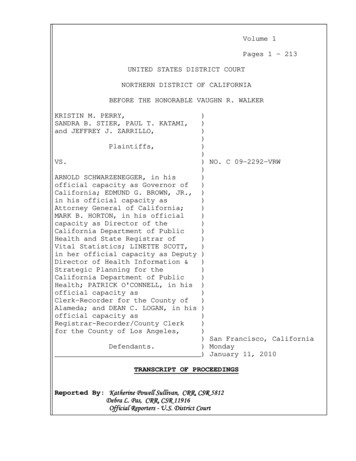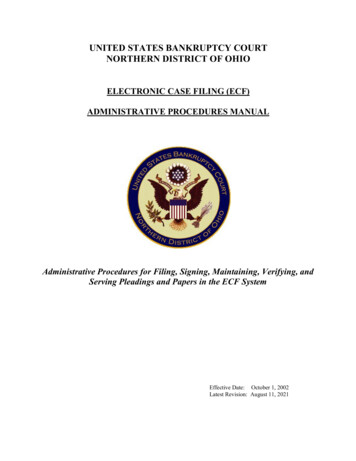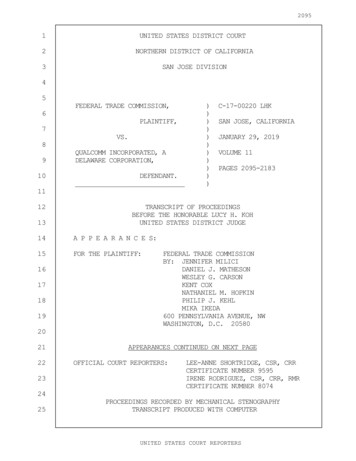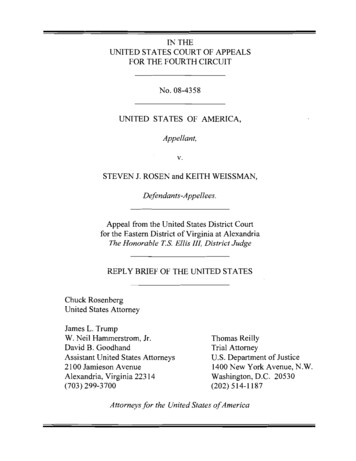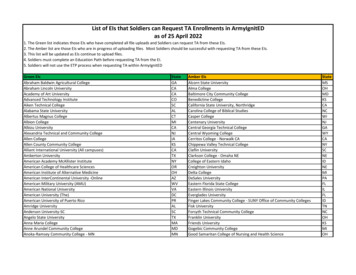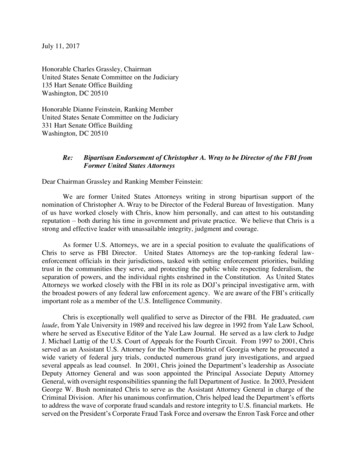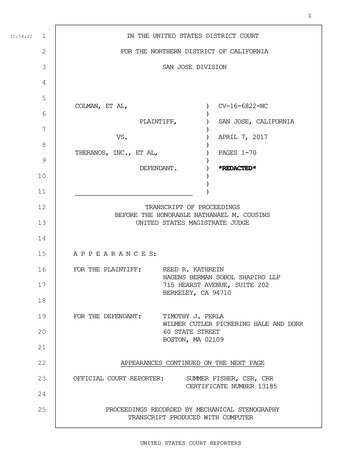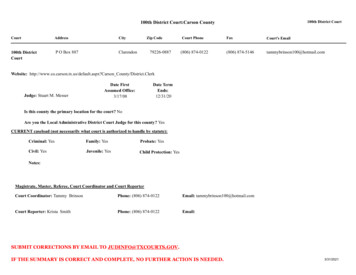
Transcription
Case 5:09-cv-00135-JBC Document 54Filed 02/22/10 Page 1 of 31UNITED STATES DISTRICT COURTEASTERN DISTRICT OF KENTUCKYCENTRAL DIVISIONLEXINGTONCIVIL ACTION NO. 09-135-JBCASHLAND INC., ET AL.,V.PLAINTIFFS,MEMORANDUM OPINION AND ORDEROPPENHEIMER & CO., INC.,DEFENDANT.***********This matter is before the court on the defendant’s motion to dismiss. R. 40,41. For the reasons discussed below, the court will grant the motion.I.BackgroundThe plaintiffs, Ashland Inc. and AshThree LLC (collectively referred to as“Ashland”), sued the defendant, Oppenheimer Inc. (“Oppenheimer”), alleging thatOppenheimer made false and misleading statements and material omissions aimedat inducing Ashland to hold and to continue to purchase “auction rate securities”(ARS) at a time when Oppenheimer knew the market for those securities wascollapsing. Compl. ¶1. Ashland’s claims include fraud in violation of Section 10(b)of the Securities and Exchange Act of 1934 and Rule 10b-5 promulgatedthereunder, fraud in violation of K.R.S. 292.320 and 292.480, common-law fraud,promissory estoppel, and negligent misrepresentation. Id. at ¶89-119.A.ARS1
Case 5:09-cv-00135-JBC Document 54Filed 02/22/10 Page 2 of 31In or around May 2007, Ashland engaged Oppenheimer to provideinvestment and cash-management services. Compl. ¶27. Beginning in June 2007,based on representations by Oppenheimer, Ashland began purchasingOppenheimer-brokered ARS. Id. at ¶28. ARS combine long-term maturityborrowing with interest rates linked to short-term money markets through periodicauctions, which are typically held every 7, 14, 28, or 35 days. Id. at ¶2. Becauseof the short intervals between auctions, ARS pay interest rates or dividend yieldsthat are consistent with lower, short-term rates, but typically higher than those paidby treasuries or money markets. Id. These auctions aim to enable investors toeasily liquidate their ARS at the end of each period, and are typically conducted bythe same large financial institutions that provide the issuers of the ARS withunderwriting services (the “Lead Underwriters”). Id. at ¶29. Financial institutionscreate and broker ARS based on several types of debt obligations and other assets,including the obligations of municipal governments and pools of federally insuredstudent loans (student loan auction rate securities, known as “SLARS”). Id. at¶30.In the event that the number of ARS holders selling their securities at anauction outnumbered investors bidding for those instruments, the auction is said tohave failed. Comp. ¶31. In the event of auction failure, none of the investorsholding those ARS can sell their securities and the instruments are illiquid until thenext auction. Id. During this holding period, the ARS pay investors a higher2
Case 5:09-cv-00135-JBC Document 54Filed 02/22/10 Page 3 of 31“penalty rate” or “fail rate” to penalize insurers, compensate investors for thetemporary illiquidity, and create new liquidity by inducing new investors to step into benefit from the higher interest rate. Id. Fail rates vary depending on the ARS,and are determined by the terms under which the particular security has beenissued. Id. The fail rates for Oppenheimer-brokered ARS, however, were capped atlow maximums, rendering those securities less attractive to investors in the eventof auction failure. Id. at ¶38. This fail rate was not disclosed to Ashland untilafter the collapse of the ARS market. Id. at ¶55.Both the Lead Underwriters and downstream brokers, includingOppenheimer, marketed ARS as beneficial to investors, representing that ARS wereas safe and liquid as money-market instruments, but with a slightly higher yield tocompensate for the time intervals between auctions. Compl. ¶29. Unbeknownstto Ashland, there was often insufficient third-party demand for Oppenheimerbrokered ARS, and Lead Underwriters routinely purchased these ARS, preventingauction failure. Id. at ¶36. Yet as “Oppenheimer knew, but concealed fromAshland” the Lead Underwriters’ commitment to providing liquidity for ARS wouldextend only as far as the Lead Underwriters deemed providing such liquidity to be intheir own best interest. Id. at ¶37. In fact, the Lead Underwriters had imposed alimit on the amount of ARS that they would purchase for their own inventories. Id.B.Auction failuresIn early January 2008, Ashland learned that one of the Lead Underwriters,3
Case 5:09-cv-00135-JBC Document 54Filed 02/22/10 Page 4 of 31Goldman Sachs, had allowed an auction for SLARS by student lender FirstMarblehead to fail. Compl. ¶59. Although Ashland did not own any FirstMarblehead SLARS, it was alarmed by the news of the auction failure, andcontacted Sherri L. Castner, Oppenheimer’s Executive Director of Investments, todiscuss its implications for other Oppenheimer-brokered SLARS. Id. Castnercharacterized the First Marblehead failure as an “aberration” and represented thatOppenheimer-brokered ARS remained safe, liquid investments. Id. at ¶60. Castneralso continued to aggressively market SLARS to Ashland, who continued to holdthe Oppenheimer-brokered SLARS it had purchased and to make additionalpurchases. Id. at ¶60.On January 18, 2008, Greg White, the Managing Director of Oppenheimer’sAuction Rate Department, sent an email to high-ranking personnel in thatdepartment, seeking their assessment of the risks present in Oppenheimer’s ARSbusiness. Compl. ¶63. In response, the Senior Vice President and supervisor ofOppenheimer’s ARS Desk, Louis Gelormino, acknowledged that if a firm throughwhich Oppenheimer was participating in auctions abruptly exited the business, thenOppenheimer would have to quickly find another party to accept their bidding rightsand process orders. Id. Gelormino also noted that if a Lead Underwriter declined toplace a proprietary bid to prevent auction failure, then Oppenheimer may not beable to sell shares. Id. On January 23, 2008, another substantial Lead Underwriterof ARS, Lehman Brothers (“Lehman”), chose not to place a proprietary bid in some4
Case 5:09-cv-00135-JBC Document 54Filed 02/22/10 Page 5 of 31auctions, resulting in auction failure. Compl. ¶64. Several days later, anotherfinancial firm, Piper Jaffrey (“Piper”), declined to place sufficient proprietary bidsand allowed auctions to fail. Id. at ¶ 65.1.Oppenheimer executives liquidated their personal ARS holdings.During this time period, several Oppenheimer executives chose to liquidatetheir personal ARS holdings. Oppenheimer’s Chairman and CEO, Albert Lowenthal,liquidated 2,650,000 worth of his personal ARS holdings between December 1,2007 and the market’s collapse of February 12, 2008; White sold 100,000 worthof ARS in his wife’s business account on February 3, 2008, and, followingadditional Goldman ARS auctions on February 7, 2008, 275,000 of personal ARSholdings from his account; Larry Spaulding, Chief Operating Officer, similarly sold 100,000 of his own ARS holdings on February 7, 2008. Id. at ¶69, 71, 75,Despite the Goldman auction failure on February 7, 2008, Oppenheimer continuedto solicit SLARS and Ashland continued to purchase them. Id. at § ¶76-77.2.The market’s collapse.On February 11, 2008, Oppenheimer executives met to discuss the ARSmarket. At the close of this meeting, “Oppenheimer had concluded that there wereparticular problems concerning SLARS, such as those sold to Ashland.” Compl. at¶78. The ARS market imploded the very next day, February 12, 2008. Id.Following the market collapse, Ashland directed Oppenheimer to begin liquidatingits Oppenheimer-brokered ARS holdings. Id. at 79. Castner informed Joseph R.5
Case 5:09-cv-00135-JBC Document 54Filed 02/22/10 Page 6 of 31Broce, Ashland’s Assistant Treasurer, that, contrary to Oppenheimer’s repeatedrepresentations concerning the liquidity of SLARS, Oppenheimer was unable toprovide liquidity for any Oppenheimer-brokered SLARS. Id.At this point, Ashland discovered that with the Lead Underwriters no longerstepping in to provide liquidity, Oppenheimer-brokered SLARS were illiquid due toinsufficient third-party demand. Id. at ¶80. As of February 12, 2008, Ashlandheld more than 194 million of illiquid Oppenheimer-brokered-SLARS. Id. Ashlandhas been forced to discount the value of its illiquid SLARS holding by tens ofmillions of dollars due to the lack of a market for these securities, and to the extentit has been able to make isolated sales of its SLARS, it has incurred millions ofdollars of losses in connection with these transactions. Id. at ¶86. Furthermore,Ashland has been unable to access cash “currently trapped in Oppenheimerbrokered SLARS.” Id. at ¶87.II.Count One: Violations of Section 10(b) of the Securities Exchange Act of1934 and Rule 10b-5A.StandingAshland Inc. has standing to pursue fraud claims against Oppenheimer underfederal and state law. Count One of the complaint alleges fraud in violation ofSection 10(b) of the Securities Exchange Act of 1934 and Rule 10b-5 promulgatedthereunder. Rule 10b-5 provides that it shall be unlawful for any person, directly orindirectly, by the use of any means or instrumentality of interstate commerce, orthe mails or of any facility of any national securities exchange,6
Case 5:09-cv-00135-JBC Document 54Filed 02/22/10 Page 7 of 31(a) To employ any device, scheme, or artifice to defraud(b) To make any untrue statement of a material fact or to omit to state amaterial fact necessary in order to make the statements made, in the light ofthe circumstances under which they were made, not misleading, or(c) To engage in any act, practice, or course of business which operates orwould operate as a fraud or deceit upon any person, in connection with thepurchase or sale of any security.17 C.F.R. 240.10b-5 (emphasis added). Oppenheimer argues that Ashland Inc.lacks standing because it did not purchase the securities in question – rather,AshThree LLC purchased them. Ashland Inc. counters that it has standing becausea parent is considered the de facto purchaser of securities actually purchased by awholly owned subsidiary.The class of plaintiffs who may maintain a private cause of action for moneydamages for violations of Rule 10b-5 is “limited to actual purchasers and sellers.”Blue Chip Stamps v. Manor Drug Stores, 421 U.S. 723, 731-32 (1975). This rulebars three principal classes of plaintiffs: (1) potential purchasers who allege thatthey decided not to purchase due to an “unduly gloomy representation or theomission of favorable material”; (2) shareholders in the issuer who allege that theydid not sell their shares because of “an unduly rosy representation or a failure todisclose unfavorable material”; and (3) shareholders, creditors, and others related toan issuer who suffered loss in the value of their investment due to corporate orinsider activities in connection with the purchase or sale of securities which violateRule 10b-5. Id. at 737-38. This limitation “avoids vexatious litigation by ensuring7
Case 5:09-cv-00135-JBC Document 54Filed 02/22/10 Page 8 of 31that the conduct of the parties and the resulting damages are objectivelydemonstrable.” Grubb v. FDIC, 868 F.2d 1151, 1161 (10th Cir. 1989).The “actual purchasers and sellers” requirement is not limited to the literalmeaning of that term. For example, one plaintiff had standing where he formed theholding company that purchased the stock in question following the defendant’salleged representation. Grubb v. FDIC, 868 F.2d 1151, 1162 (10th Cir. 1989).Although the plaintiff did not personally purchase the stock, he was deemed the“actual purchaser” within the rationale of Blue Chip because he executed apromissory note for the loan that financed the stock purchase, he personallyguaranteed the holding company’s loan, and he suffered a direct injury as a result.Id.The same rationale applied in United Dept. Stores v. Ernst & Whinney, 713F. Supp. 518 (D.R.I. 1989). As in Grubb, the individual plaintiffs were not suingfor the diminution of their own stock, but rather for the direct injury they sufferedas a result of their 500,000 in contributions and their guarantee made in relianceon the defendant’s advice. Thus the individual plaintiffs “were the actual parties atrisk in the [] transaction to the extent of their direct investment and guaranty of[the note].” Id. at 524.This case is somewhat distinguishable from Ernst and Grubbs because thepurchase at issue was financed purely through a capital contribution as opposed tosome sort of loan arrangement. Given the nature of the parent/subsidiary8
Case 5:09-cv-00135-JBC Document 54Filed 02/22/10 Page 9 of 31relationship, however, Ashland Inc. constitutes an actual purchaser under themeaning of the statute. As the parent of a wholly owned subsidiary, Ashland Inc.exercised complete control over AshThree LLC, and any losses AshThree sustainedwould be reflected in their consolidated financial statements. Moreover, AshlandInc. does not fall into any of the three classes of plaintiffs that the Supreme Courtsought to preclude in Blue Chip. Ashland Inc. is therefore a purchaser according toRule 10b-5, and is not barred from pursuing its federal securities fraud claims.Oppenheimer also argues that AshThree lacks standing because it can simplyhold the now-illiquid securities through maturity, at which point it will recoup itsinvestment. First, this argument ignores Ashland’s claim that it has made some“isolated sales” of its Oppenheimer-brokered SLARS, which resulted in a loss.Compl. ¶86. It also ignores the fact that Ashland seeks to rescind itsOppenheimer-brokered SLARS purchases. In some circumstances, plaintiffs in§10(b) cases may opt for rescission in lieu of out-of-pocket damages. Randall v.Loftsgaarden, 478 U.S. 647, 662 (1986); Stone v. Kirk, 8 F.3d 1079, 1092 (6thCir. 1993). Thus, the fact that the plaintiffs may eventually recover the originalvalue of their investment (which does not account for interest) does not barAshland from pursuing rescission.B.Judicial Notice of Information Outside the ComplaintOppenheimer has requested that the court take judicial notice of severaldocuments submitted as exhibits to its motion to dismiss. R. 41, Ex. A-Q. These9
Case 5:09-cv-00135-JBC Document 54Filed 02/22/10 Page 10 of 31documents include Ashland’s complaint against Morgan Stanley (R. 41, Ex. A);excerpts from Ashland Inc.’s 2008 Form 10-K, which is a required SEC filing (id. atEx. B); AshThree’s brokerage statements reflecting its SLARS purchases fromOppenheimer (id. at Ex. C); excerpts from disclosure documents for each of theSLARS listed in the amended complaint (id. at Ex. D-O); disclosures available onOppenheimer’s website at the time of the purchases (id. at Ex. P); and a redlinecomparison of the original and amended complaint (id. at Ex. Q).Courts may take judicial notice of information “publicly available toreasonable investors at the time the defendant made the allegedly falsestatements.” Beaver Cty. Ret. Bd. v. LCA-Vision, Inc., No. 1:07-cv-750, 2009U.S. Dist. LEXIS 31375 at *13 (S.D. Ohio Mar. 25, 2009). This includesdocuments such as SEC filings, prospectuses, and statements “integral to thecomplaint.” Id. (citations omitted). A court may consider any matters of which acourt may take judicial notice without converting a party’s motion to dismiss into amotion for summary judgment. In re Cardinal Health, Inc. Sec. Litigs., 426 F.Supp. 2d 688, 712 (S.D. Ohio 2006). The court may take judicial notice of thesedocuments, however, only to the extent that their existence or contents “provefacts whose accuracy cannot be reasonably questioned.” Id. (citation omitted).Moreover, “[a] judicially noticed fact must be one not subject to reasonable disputein that it is either (1) generally known within the territorial jurisdiction of the trialcourt or (2) capable of accurate and ready determination by resort to sources10
Case 5:09-cv-00135-JBC Document 54Filed 02/22/10 Page 11 of 31whose accuracy cannot reasonably be questioned.” Fed. R. Evid. 201(b).Therefore, with the exception of the online ARS disclosure document,1 thecourt takes judicial notice of the existence of the attached documents for thelimited purpose of recognizing their existence. The underlying arguments made bythe parties, disputed facts, and any inferences one might draw from these materialsare not the subject of judicial notice, however. See Ramirez v. United Airlines Inc.,416 F. Supp. 2d 792 (N.D. Cal. 2005).C.The Heightened Pleading Requirements of Rule 9(b) and the PSLRATo survive a motion to dismiss, a complaint must state “a plausible claim forrelief.” Ashcroft v. Iqbal, 129 S.Ct. 1937, 1950 (2009). Plausibility exists “whenthe plaintiff pleads factual content that allows the court to draw the reasonableinference that the defendant is liable for the misconduct alleged.” Id. at 1949(citation omitted). Where the facts alleged are merely “consistent with” adefendant’s liability, the claim fails to cross the line between “possibility andplausibility of ‘entitlement to relief.’” Id. (citation omitted).The instant lawsuit is also subject to Rule 9(b) of the Federal Rules of CivilProcedure, which requires that claims of fraud be pled with particularity. Fed. R.Civ. Pro. 9(b). In addition, the Private Securities Litigation Reform Act (“PSLRA”)1The court may consider the online ARS disclosure document because it is central toAshland’s claim that it contained material omissions. See Com pl. ¶38; see also Benzon v. MorganStanley Distrib., Inc., 420 F.3d 598, 603-04 (6th Cir. 2005) (allow ing consideration of docum entsattached to a motion to dismiss because they were central to the claim that those documentscontained material omissions and misrepresentations and the other party acknowledged it had reliedon them).11
Case 5:09-cv-00135-JBC Document 54Filed 02/22/10 Page 12 of 31imposes more exacting pleading standards that require plaintiffs to state withparticularity both the facts constituting the alleged violation and the factsevidencing scienter. U.S.C. § 78u-4(b)(2). With respect to the factual allegations, acomplaint must “specify each statement alleged to have been misleading, thereason or reasons why the statement is misleading, and, if an allegation regardingthe statement or omission is made on information or belief, the complaint shallstate with particularity all facts on which that belief is formed.” 15 U.S.C. §78u4(b)(1).1.The Allegations of Fraud Do Not Meet the ParticularityRequirements of the PSLRA.Ashland alleges that Oppenheimer’s material misrepresentations andomissions regarding the health of the market for SLARS induced Ashland toparticipate in that market based on false pretenses. In May 2007 Broce, Castner,and Oppenheimer’s Senior Financial Associate, Lenee C. Firlit, met to discussinvestment options for the acquisition principal. Compl. ¶24. This meeting andfollowup conversations occurred “in and from” Broce’s office in Lexington,Kentucky. Id. “At this initial meeting, Ashland explicitly described to Oppenheimerits need for safety and liquidity with respect to the [a]cquisition [p]rincipal.” Id.Ashland states that during these initial communications, Oppenheimer “marketeditself aggressively” and “touted the high level of investment and cash managementexpertise and service with which it could provide [Ashland].” Id. at ¶25. Inreliance on these representations, Ashland engaged Oppenheimer to provide12
Case 5:09-cv-00135-JBC Document 54Filed 02/22/10 Page 13 of 31“investment and cash management services,” and began purchasing Oppenheimerbrokered ARS on June 5, 2007. Compl. ¶27.Ashland goes on to state that in order to induce Ashland to engageOppenheimer to provide these services, Castner and others made several materialrepresentations concerning ARS. Specifically, Oppenheimer represented thatOppenheimer-brokered ARS (1) were of the highest available quality; (2) werecomparable to money markets in terms of safety and liquidity; and (3) offered theideal investment opportunity for the acquisition principal. Compl. ¶33. At thesame time, Ashland alleges, Oppenheimer failed to disclose the true liquidity risksassociated with those securities or the extent of Oppenheimer’s financial interest inmaintaining the ARS market in order to generate fees. Compl. ¶36-38.Ashland also provides excerpts from a series of emails from Castner to Brocefollowing the Goldman Sachs auction failure in January 2008, in which Castnersolicits SLARS purchases. Compl. ¶66-67. Ashland alleges that marketing thesesecurities to Ashland at that point in time constituted a material misrepresentationthat the ARS market remained safe and liquid. Id. at ¶66-68.In July 2007, Oppenheimer advised Ashland to refocus its investmentstrategy from ARS backed by monoline insurers to SLARS. Around that time,Castner represented that “in the event of any disequilibrium, the Lead Underwriterswould place proprietary bids to prevent auctions for Oppenheimer-brokered SLARSfrom failing,” and that Oppenheimer “could ensure immediate liquidity for these13
Case 5:09-cv-00135-JBC Document 54Filed 02/22/10 Page 14 of 31SLARS because their high quality and FFELP guarantee would attract otherinvestors to purchase those SLARS.” Compl. ¶47.Ashland’s allegations largely fail to identify the specific date or location ofthe alleged misrepresentations. At a minimum, a plaintiff must allege the “time,place, and content of the alleged misrepresentation on which he or she relied,” inaddition to other requirements. Frank v. Dana Corp., 547 F.3d 564, 570 (6th Cir.2008) (noting that a plaintiff’s complaint must “state where and when the[fraudulent] statements were made”); see also Brightman v. Freeway Assoc., No.90-4072, 1991 U.S. App. LEXIS 19069 at *7 (6th Cir. Aug. 8, 1991) (explainingthat plaintiffs in Rule 9(b) cases must relate particular misrepresentation to dates).Other circuits have also held that plaintiffs failed to comply with theheightened pleading standards of Rule 9(b) by not including sufficient informationregarding the time and place of the alleged misrepresentation or omission. SeeKlein v. Autek Corp., No. 04-3072, 2005 U.S. App. LEXIS 19155 at *11 (3d. Cir.Sept. 1, 2005) (explaining that references to vague and generic time frames like “atthat time” or “in or about February 2000" are insufficient to satisfy Rule 9(b)); In reCitigroup Auction Rates Securities Litigation, 2009 WL 2914370 at *5 (noting theplaintiff’s failure to include specific allegations regarding which defendantsperformed what acts at what times and with what effect). The purpose of thisrequirement is to give defendants fair notice of the allegations against them so theycan prepare an informed pleading responsive to the specific allegations of fraud.14
Case 5:09-cv-00135-JBC Document 54Filed 02/22/10 Page 15 of 31See United States, ex rel. Snapp, Inc. v. Ford Motor Co., 532 F.3d 496, 503-04(6th Cir. 2008). Although the omission of precise dates is not automatically fatalto the complaint, it ultimately undermines Ashland’s allegations by making itdifficult to assess whether the statements in question were false or misleadingwhen made and the materiality of any omission.Ashland alleges that Oppenheimer made several material omissions andmisrepresentations regarding the safety and quality of ARS and SLARS. Ashlandalleges that Oppenheimer made false statements regarding the relative quality andliquidity of SLARS compared to other ARS and the nature, credit quality, and risksassociated with Oppenheimer-brokered ARS and SLARS. Compl.¶90(i),(iii),(iv),(vii).With respect to the safety and liquidity of SLARS, Ashland has not pled factssuggesting that these statements were false or misleading when made. Ashlanddoes not identify the point at which its holdings became illiquid. Based on the factsalleged, it appears that Ashland’s SLARS holdings became illiquid when the marketfor these securities collapsed on February 12, 2008. In other words, Ashland doesnot allege that had it attempted to liquidate its holdings earlier, it would not havebeen able to do. That these securities became illiquid does not automatically renderOppenheimer’s statements actionable. Konkol v. Diebold, Inc., No. 08-4572, 2009U.S. App. LEXIS 28194 at *14-15 (“Without specific allegations showing that theDefendants either knew of or recklessly disregarded the falsity of their ownstatements at the time the statements were made, the fact that their statements15
Case 5:09-cv-00135-JBC Document 54Filed 02/22/10 Page 16 of 31later turned out to be false is irrelevant to a cause of action under the PSLRA.”).Similarly, Ashland alleges that Oppenheimer made misleading representationsand material omissions regarding the quality of SLARS due to their AAA creditrating. Ashland alleges that Oppenheimer touted this credit rating, yet “knew orshould have known that low [fail] rates would negatively impact the liquidity of theSLARS in the event of disruptions in the ARS market.” Compl. ¶53. For example,Ashland notes that Oppenheimer’s ARS disclosure document, available tocustomers online, did not disclose the maximum fail rate in the event of auctionfailure. Compl. ¶38. That same document, however, cautioned that the methodfor calculating the maximum rate was specified in the offering documents of eachsecurity, that such rates varied, and that Oppenheimer could not ensure an auctionwould clear at a rate favorable to the investor. R. 41, Exh. 18 at 9, 13. Ashlandtherefore fails to allege with sufficient particularity that Oppenheimer’s allegedfailure to disclose additional information regarding the maximum fail rate in theonline disclosure document constituted a material omission. See Ley v. VisteonCorp., 543 F.3d 801, 803 (6th Cir. 2008). Moreover, Ashland has not allegedwith sufficient particularity that Oppenheimer’s statements regarding the AAAcredit rating were false or misleading when made. Ashland asserts that the AAAratings associated with Oppenheimer-brokered ARS were achieved “at the expenseof” maximum fail rates high enough to ensure liquidity, and that Oppenheimer“knew or should have known that low rates would negatively impact the liquidity of16
Case 5:09-cv-00135-JBC Document 54Filed 02/22/10 Page 17 of 31the SLARS in the event of disruptions in the ARS market.” Compl. ¶52-53.Although Ashland alleges that Oppenheimer touted the AAA credit ratings asevidence of the safety and liquidity of Oppenheimer-brokered ARS, it has notidentified a particular statement by Oppenheimer similarly equating this credit ratingwith liquidity. See 15 U.S.C. §78u-4(b)(1) (stating that a complaint shall “specifyeach statement alleged to have been misleading”). Thus Ashland fails to allegewith sufficient particularity that Ashland made material misrepresentationsregarding the AAA credit rating.Ashland also alleges that Oppenheimer made several material omissions andfalse statements regarding the extent of the Lead Underwriters’ participation in theSLARS market. Specifically, Ashland alleges that Oppenheimer made falsestatements regarding how often the Lead Underwriters placed proprietary bids andtheir willingness to continue doing so. Compl.¶90(ii); 91(ii), (iii). Ashland alsoalleges that Oppenheimer made several material omissions regarding the state ofthe market for SLARS, including that sales of Oppenheimer-brokered ARS andSLARS were outstripping genuine third-party demand, that liquidity existed as aresult of discretionary management by the Lead Underwriters, that the LeadUnderwriters had increased purchases of Oppenheimer-brokered ARS and SLARS toprevent auction failures, and that the Lead Underwriters were contemplating “whenand how to end their practice of buying unwanted ARS and SLARS.” Compl.¶91(vi), (vii), (viii), (xi). Ashland acknowledges, however, that Oppenheimer17
Case 5:09-cv-00135-JBC Document 54Filed 02/22/10 Page 18 of 31“represented that the Lead Underwriters and others conducting ARS auctions hadnever allowed an auction to fail, and would continue to act to prevent such anoccurrence.” Compl. ¶34 (emphasis added). Moreover, Ashland does not allegethat Oppenheimer promised that the Lead Underwriters would continue “inperpetuity” to purchase SLARS in order to ensure successful auctions (R. 41, 20)or that Oppenheimer promised that buyer demand for these securities wouldcontinue. Ashland was therefore aware that Lead Underwriters had preventedauction failure in the past, and that such intervention might be necessary in thefuture. Ashland therefore fails to plead with requisite particularity thatOppenheimer’s statements or omissions were false or misleading when made.Ashland also alleges that Oppenheimer failed to disclose its “significantfinancial interest” in Ashland’s continued purchase and retention of ARS andSLARS, and that the Lead Underwriters would buy Oppenheimer-brokered ARS andSLARS only to the extent that “doing so would be in their own commercial bestinterests. Compl. ¶91(i),(iv). Ashland does not allege, however, that it wasunaware that Oppenheimer received fees for its ARS and SLARS sales, as wouldany broker. Ashland also does not explain why it would have expected the LeadUnderwriters to continue buying such securities if it was not in their commercialbest interest, absent an explicit agreement to the contrary.For these reasons, the complaint does not allege with the requiredparticularity that Oppenheimer made material misrepresentations and/or omissions18
Case 5:09-cv-00135-JBC Document 54Filed 02/22/10 Page 19 of 31in order to induce Ashland to purchase Oppenheimer-brokered ARS and SLARS.2.Ashland Has Not Alleged Scienter with SufficientParticularity.Securities-fraud plaintiffs must also "state with particularity facts giving riseto a strong inference that the defendant acted with the required state of mind." 15U.S.C. § 78u-4(b)(2). A “strong inference” must be cogent and at least ascompelling as any opposing inference of nonfraudulent intent. Tellabs, Inc. v.Makor Issues & Rights, Ltd., 551 U.S. 308, 314
Oppenheimer, marketed ARS as beneficial to investors, representing that ARS were as safe and liquid as money-market instruments, but with a slightly higher yield to compensate for the time intervals between auctions. Compl. ¶29. Unbeknownst to Ashland, there was often insufficient third-party demand for Oppenheimer-

